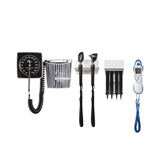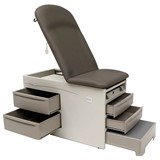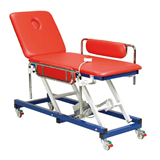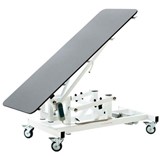I. Introduction
Examination tables play a vital role in medical settings, providing a platform for various diagnostic and treatment procedures. These essential pieces of equipment must function seamlessly to ensure accurate patient assessments and overall healthcare efficiency. However, like any mechanical system, examination tables are susceptible to issues and malfunctions over time. In this comprehensive guide, we will delve into the troubleshooting and resolution of common problems that may arise with examination tables.
II. Identifying and Diagnosing Common Problems in Examination Tables
A. General Inspection Techniques
To begin the troubleshooting process, a thorough and systematic inspection of the examination table is crucial. This involves visually examining the table for any visible damage, irregularities, or misalignments. By adopting a structured approach to inspection, potential issues can be detected early, preventing them from escalating into major problems.
B. Observing Stability and Balance
Stability is paramount when it comes to examination tables. We will explore the factors that contribute to table stability and how to assess its balance accurately. Proper leveling is essential for patient safety and comfort during examinations, and we will outline the steps to ensure the table remains stable and balanced.
C. Assessing Mechanical Components
Examination tables incorporate various mechanical components that enable their adjustable and motorized features. Understanding these components and their interplay is essential for effective diagnosis of mechanical problems. We will provide insights into the most common mechanical issues and the methods to assess their functionality.
D. Checking Power and Motorization
Motorized examination tables are equipped with electrical systems that drive their movement. When these systems encounter malfunctions, they can significantly impact the table's usability. We will guide you through the process of checking power sources, electrical connections, and motor performance to identify and address potential power-related issues.
III. Addressing Stability and Leveling Issues with Adjustable Examination Tables
A. Verifying Stability Problems:
- The first step in addressing stability issues is to verify the problem accurately. Medical staff should carefully observe and assess the table's stability during routine checks or when patients report discomfort.
- Look for any wobbling, unevenness, or unexpected movement of the table during patient positioning or adjustments.
B. Adjusting Table Leveling Mechanism:
- Many adjustable examination tables come with leveling mechanisms that allow users to fine-tune the table's stability. Refer to the manufacturer's guidelines on how to adjust the leveling mechanism correctly.
- Use appropriate tools and follow safety precautions while making adjustments to avoid any mishaps.
C. Ensuring Safety Measures:
- Safety should be a top priority when dealing with examination tables. Check for any loose bolts, screws, or other fasteners that may compromise the table's stability.
- Regularly inspect hydraulic or motorized components for signs of wear and tear, and replace them promptly if needed.
- Train medical staff on proper usage and weight capacity limits of the examination table to prevent overloading and potential accidents.
IV. Handling Mechanical Malfunctions and Maintenance for Hydraulic Examination Tables
Hydraulic examination tables are essential equipment in medical facilities, providing versatility and convenience during patient examinations. However, like any mechanical system, they can encounter issues that may disrupt their functionality. This section will provide a comprehensive guide on how to handle mechanical malfunctions and perform regular maintenance for hydraulic examination tables, ensuring optimal performance and prolonging their lifespan.
A. Understanding Hydraulic System Components
To effectively troubleshoot and maintain hydraulic examination tables, it is crucial to have a clear understanding of their key components. The hydraulic system typically comprises the following elements:
- Hydraulic Pump: The heart of the hydraulic system, responsible for generating pressure to move the table's lifting mechanism.
- Hydraulic Cylinder: Converts hydraulic pressure into mechanical force, facilitating the adjustment of the table's height and other movements.
- Control Valves: Regulate the flow of hydraulic fluid to control the speed and direction of the table's movement.
- Fluid Reservoir: Holds hydraulic fluid, ensuring a steady supply for the system.
B. Troubleshooting Hydraulic Failures
When a hydraulic examination table experiences malfunctions, it is crucial to diagnose the problem accurately. Follow these steps for effective troubleshooting:
- Visual Inspection: Conduct a thorough visual examination of the hydraulic system to check for leaks, damaged hoses, or loose connections.
- Listen for Unusual Sounds: Unusual noises during table movement may indicate air in the hydraulic system or other mechanical issues.
- Test the Controls: Check if the control valves are functioning correctly and if the table responds appropriately to commands.
- Verify Electrical Connections: In motorized hydraulic tables, ensure that all electrical connections are secure and functioning as intended.
- Pressure Testing: Use a pressure gauge to assess hydraulic pressure levels and identify potential irregularities.
C. Regular Maintenance to Prevent Issues
Regular maintenance is crucial to prevent mechanical failures and ensure the smooth functioning of hydraulic examination tables. Follow these maintenance tips:
- Fluid Inspection: Regularly check the hydraulic fluid level and quality. Contaminated or low fluid levels can lead to performance issues.
- Fluid Replacement: Follow the manufacturer's guidelines for hydraulic fluid replacement intervals to maintain optimal performance.
- Lubrication: Keep all moving parts properly lubricated according to the manufacturer's recommendations.
- Cleaning: Regularly clean the table's surface, control panels, and hydraulic components to prevent dust and debris accumulation.
- Professional Inspection: Schedule periodic inspections by qualified technicians to identify potential issues early and perform necessary repairs.
V. Troubleshooting Power and Motorization Problems in Motorized Examination Tables
Motorized examination tables are crucial assets in modern medical settings, offering enhanced functionality and convenience for medical professionals. However, like any complex equipment, they may encounter issues related to power and motorization over time. This section provides valuable insights and expert recommendations for effectively troubleshooting and resolving these problems in a professional and objective manner.
A. Identifying Electrical Malfunctions
- Power Failure: Before assuming a major issue, ensure that the examination table is connected to a functional power source. Check the power outlet, circuit breaker, and any power switches on the table.
- Faulty Power Cord: Inspect the power cord for any visible damage, such as fraying or cuts. If there are signs of damage, discontinue use immediately and replace the cord with a manufacturer-approved one.
- Control Panel Display Issues: If the control panel is not displaying or responding correctly, check for loose connections or try resetting the system as per the manufacturer's instructions.
- Blown Fuses: In case of power surges or electrical fluctuations, the examination table's fuse may blow. Locate the fuse compartment, replace the blown fuse with the correct rating, and investigate the underlying cause.
B. Checking Motor Performance
- Unusual Noises: Strange sounds coming from the motor may indicate mechanical issues. Listen for grinding, clicking, or squealing noises, and if present, turn off the table immediately to prevent further damage.
- Motor Overheating: Excessive use or electrical problems can cause the motor to overheat. If the motor feels too hot to touch, let it cool down before attempting any further troubleshooting.
- Motor Jams or Stalls: If the motorized table experiences unexpected stops or lacks smooth movement, examine the mechanical components, such as gears or belts, for signs of wear or obstruction.
- Motor Speed Irregularities: Test the various motorized functions of the table, ensuring that they are performing at the specified speed and without unexpected fluctuations.
C. Power Source Inspection
- Voltage and Current Testing: Use a multimeter or voltage tester to check the power source's voltage and current output. Ensure it aligns with the manufacturer's requirements.
- Surge Protection: Consider using surge protectors to safeguard the examination table's motor and control systems from power surges and voltage spikes.
- Battery Backup (If Applicable): If the table relies on batteries as a power source, inspect and replace them regularly to avoid power disruptions during critical procedures.
VII. Seeking Professional Assistance for Complex Examination Table Repairs
A. When to Call for Professional Help
When faced with complex issues or malfunctions in your examination table, it is essential to recognize the right time to seek professional assistance. While minor problems can often be resolved with in-house maintenance, some situations require the expertise of qualified technicians. Consider the following scenarios as indicators to call for professional help:
- Persistent Malfunctions: If the examination table consistently experiences the same issue despite repeated attempts at repair, it may indicate an underlying problem that requires specialized knowledge and tools.
- Motorization and Electrical Problems: Examination tables with motorized components or electrical systems should only be handled by trained professionals to avoid potential hazards and ensure proper repairs.
- Unusual Noises or Smells: Any unusual noises or odors emanating from the examination table could indicate a serious mechanical issue that should be addressed by experts to prevent further damage.
- Structural Damage: If there is visible structural damage to the table, such as cracks, dents, or bent parts, consulting a professional technician is crucial to assess the extent of the damage and implement appropriate repairs.
- Warranty Coverage: Attempting to repair the examination table yourself or using unauthorized personnel may void the warranty. To maintain warranty coverage and ensure proper repairs, it is advisable to consult authorized technicians.
B. Choosing a Qualified Technician
When entrusting your examination table to a professional technician, it is imperative to select a qualified and reputable individual or service. Consider the following factors while choosing a technician:
- Certification and Training: Look for technicians who are certified and have received proper training in handling examination table repairs. A certification from recognized organizations signifies their competence in the field.
- Experience: Prioritize technicians with a proven track record of working with examination tables or similar medical equipment. Experienced technicians are more likely to diagnose issues accurately and provide effective solutions.
- References and Reviews: Seek references or read online reviews from previous clients to gauge the technician's reliability, workmanship, and professionalism.
- Compliance with Regulations: Ensure that the chosen technician adheres to industry standards and safety regulations. Compliance demonstrates their commitment to quality service and patient safety.
- Timeliness and Customer Support: Opt for technicians known for their promptness and excellent customer support. A reliable technician will prioritize quick response times and clear communication.
C. Communicating Issues Effectively
Effectively communicating the issues you have encountered with your examination table is crucial for the technician to understand the problem fully. Follow these guidelines to ensure clear and accurate communication:
- Detailed Description: Provide a detailed account of the problem, including when it started, any triggering events, and any visible symptoms or abnormalities.
- Be Specific: Use technical terminology when possible to accurately describe the issue. This will help the technician in their diagnosis and ensure precision in the repair process.
- Note Recent Changes: Inform the technician of any recent changes or modifications made to the examination table, as these may be relevant to the current problem.
- Document Errors: If there were any error codes displayed on the table's control panel, document them and share them with the technician, as they can be valuable in diagnosing the problem.
- Ask Questions: Seek clarification from the technician regarding their assessment and proposed solutions. This ensures you fully understand the repairs needed and the associated costs.
VIII. Preventative Measures to Reduce the Frequency of Examination Table Issues
A. Regular Inspection and Maintenance Schedule
Regular inspection and maintenance are essential to ensure the optimal performance and longevity of examination tables. By following a structured maintenance schedule, healthcare facilities can proactively identify and address potential issues before they escalate. Here are the key steps to implement a successful inspection and maintenance routine:
- Establish a Maintenance Calendar: Create a comprehensive maintenance calendar that outlines the frequency of inspections and maintenance tasks. Consider factors such as the table's usage, manufacturer recommendations, and industry standards.
- Visual Inspection: Conduct routine visual inspections of examination tables to identify any visible signs of wear, damage, or instability. Look for loose screws, worn-out components, and irregularities in the table's surface.
- Lubrication: Keep all moving parts and mechanisms well-lubricated according to the manufacturer's guidelines. Lubrication helps reduce friction, prevents premature wear, and ensures smooth functioning.
- Height Adjustment Testing: If your examination tables are equipped with adjustable height features, regularly test and calibrate the height adjustment mechanism. Verify that the table remains stable and level at different heights.
- Load Testing: Periodically conduct load testing on the table to assess its weight-bearing capacity. This helps prevent unexpected table failures during patient examinations.
- Cleaning and Sanitization: Maintain a rigorous cleaning and sanitization routine for examination tables, especially in medical settings. Use appropriate cleaning agents and disinfectants to ensure a hygienic environment for patients.
- Record Keeping: Keep detailed records of all inspections, maintenance tasks, and repairs performed on each examination table. This documentation can provide valuable insights and aid in tracking the table's performance over time.
B. Proper Handling and Usage Guidelines
Proper handling and usage of examination tables play a pivotal role in their overall lifespan and functionality. By adhering to these guidelines, healthcare practitioners can prevent unnecessary strain and damage to the tables:
- Weight Limits: Educate all users about the recommended weight limits for the examination table. Avoid exceeding these limits, as it may lead to structural damage and compromise patient safety.
- Patient Positioning: Instruct healthcare staff on the correct methods of positioning patients on the table. Avoid sudden or jerky movements that could put excessive stress on the table's components.
- Folding and Unfolding: If the table is foldable, follow the designated folding and unfolding procedures provided by the manufacturer. Improper folding can lead to misalignment and difficulty in extending the table back to its original position.
- Caution with Accessories: Ensure that any accessories or attachments used with the examination table are compatible and installed correctly. Inappropriate accessories might cause malfunctions or instability.
- Transport and Storage: During transportation or storage, handle the examination table with care to avoid impact or collision that could result in damage.
- Reporting Issues: Encourage all staff members to promptly report any observed issues or abnormalities with the examination tables. Early reporting can prevent minor problems from turning into major repairs.
C. Staff Training and Education
Well-trained medical staff can significantly contribute to the proper usage and maintenance of examination tables. Providing comprehensive training and education ensures that staff members are knowledgeable and proficient in handling the equipment:
- Training Sessions: Conduct regular training sessions that cover examination table operation, maintenance procedures, and troubleshooting techniques. Involve both new and experienced staff members to maintain consistency in knowledge.
- Manufacturer's Manuals: Distribute and emphasize the importance of reading the manufacturer's manuals for each examination table model. These manuals contain valuable information regarding proper usage and maintenance guidelines.
- Ongoing Education: Stay updated on the latest advancements and best practices in examination table usage through continuous education and professional development programs.
- Reporting Protocols: Establish clear protocols for reporting any issues with examination tables. Encourage open communication between staff and management to address concerns promptly.
In conclusion, a thorough understanding of troubleshooting and addressing common issues with examination tables is vital for maintaining the efficiency and functionality of these essential medical tools. By adopting a systematic approach to identifying problems and implementing prompt resolutions, healthcare facilities can ensure accurate patient assessments and enhance overall healthcare delivery.


















